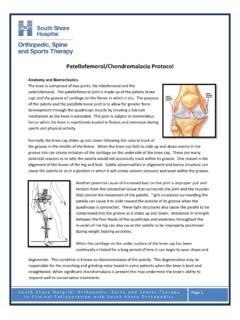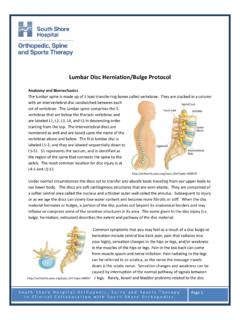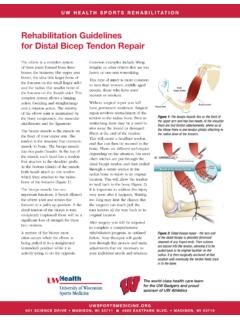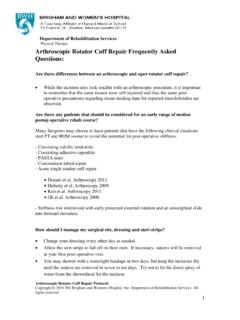Transcription of ACL Non-Operative Protocol - South Shore Orthopedics
1 South Shore Hospital Orthopedic, Spine and Sports Therapy in Clinical Collaboration with South Shore Orthopedics Page 1 ACL Non-Operative Protocol Anatomy and Biomechanics The knee is a hinge joint connecting the femur and tibia bones. It is held together by several important ligaments. The most important ligament to the knee s stability is the Anterior Cruciate Ligament (ACL). The ACL attaches from the front part of the tibia to the back part of the femur. The purpose of this ligament is to keep the tibia from sliding forward and rotating on the femur. For this reason, the ACL is most susceptible to injury when twisting or rotational forces are placed on the knee.
2 Although this can happen with contact, approximately 70% of ACL tears occur during non-contact events when athletes are cutting, decelerating or landing from a jump. After the ACL is torn, the knee is less stable and it becomes difficult to maintain a high level of activity without the knee buckling or giving way. It is particularly difficult to perform the repetitive cutting and pivoting that is required in many sports. Treatment Options Regardless of how the ACL is torn, your physician will work with you to determine a personalized course of treatment. People participating in sports or work related activities that require a lot of pivoting, cutting, or jumping may decide to have surgery.
3 Depending on your lifestyle, however; conservative treatment may be the best option. In the case of an isolated ACL tear with no other ligamentous or cartilage involvement, the associated pain and dysfunction can be successfully treated with physical therapy. The initial course of treatment in physical therapy includes rest, anti-inflammatory measures and activity modification. After the swelling resolves and normal range of motion and strength is achieved, a decision between you and your physician can be made to determine further treatment options. If a non-surgical approach is chosen, it is imperative to maintain the strength, balance, and range of motion you gained in physical therapy to avoid further injury.
4 At this juncture, many people elect to use a sports brace and limit their participation in activities that require a lot of pivoting, cutting or jumping. If conservative measures are unsuccessful and recurrent buckling persists, you and your physician may elect to have the ACL reconstructed. Recovery/Time off Work South Shore Hospital Orthopedic, Spine and Sports Therapy in Clinical Collaboration with South Shore Orthopedics Page 2 Recovering from a torn ACL is not an easy process. It can be a long and difficult recovery that requires a tremendous commitment to rehabilitation. You must be an active participant during this process, performing daily exercises to ensure the return of your range of motion and strength.
5 Recovery for a Non-Operative ACL tear is variable and largely dependent on your goals. People with desk jobs may take up to one week off from work due to pain. Manual laborers can be out of work for up to 6-8 weeks. Athletes will not be able to return to their sport immediately and will have to avoid cutting, pivoting, and jumping. Some people can cope with their injury and return to sports but typically require at least 8-10 weeks of physical therapy. Ultimately, return to sport and work is dependent on how you progress in therapy and whether you continue to have episodes of knee buckling. Recovery is different for every individual. Your personal time table for return to activities and work will be addressed by your physician and physical therapist throughout your course of treatment.
6 At Home Immediately after the injury, resting and icing your knee can help control swelling and reduce some of your pain. Ice should be applied 3-5 times a day for 10-20 minutes at a time. Always maintain one layer between the ice and your skin. A pillow case or paper towel serves as a good barrier to protect your skin. Your surgeon may prescribe pain medicine for you after your injury. Please call the doctor s office if you have any questions regarding medication. As a result of the injury, your knee is unstable and your thigh muscles can become extremely weak. It may be difficult to support the weight of your body when walking for the first few days.
7 Crutches and/or a brace may be provided by your doctor to protect the knee from continued episodes of giving way and allow your knee to recover. Once the strength in your leg begins to return and you can demonstrate normal walking mechanics, your physical therapist will instruct you to wean away from the crutches. This typically takes less than 1-2 weeks. Surgery Sometimes, conservative treatment is unsuccessful and recurrent buckling persists. In this case, you and your physician may decide to have the ACL reconstructed. ACL reconstruction surgery is not a primary repair procedure. This means that the ligament ends cannot simply be sewn back together.
8 The new ACL must come from another source and grafted into place in the knee. There are a few different graft options used for the ACL graft and each patient should consult with his or her surgeon to determine the best choice. During the procedure, a tunnel is drilled through the tibia and the new ACL graft is passed through it and anchored into place. Regardless of what type of graft is used, having an ACL reconstruction requires a significant commitment to physical therapy. Recovery is variable and rehabilitation can take anywhere from 6 months to a year. South Shore Hospital Orthopedic, Spine and Sports Therapy in Clinical Collaboration with South Shore Orthopedics Page 3 Rehabilitation **The following is an outlined progression for rehab .
9 Time tables are approximate and advancement from phase to phase as well as specific exercises performed should be based on each individual patient s case and sound clinical judgment by the rehab professional. ** Phase 1 (Acute Phase) Goals Control pain and swelling Restore pain free ROM Improve flexibility Normalize gait mechanics Establish good quadriceps activation Precautions WBAT with crutches until demonstrates normal gait mechanics Alert physician if patient reports episodes of knee buckling Recommended Exercises Patella mobilization (Medial/Lateral, Superior/Inferior) 2 Sets of 20 Repetitions Range of Motion Belt stretch (calf/hamstring) Hold 30 Seconds 3-5 Repetitions Heel slides 2 Sets of 20 Repetitions Prone quad stretch Hold 30 Seconds 3-5 Repetitions Cycle (minimal resistance)
10 10-15 Minutes Daily Quad sets 2-3 Sets of 20 Repetitions Strength Add sets 2-3 Sets of 20 Repetitions SLR *(no Lag)* 2-3 Sets of 10-20 Repetitions Hip Abd/Add/Ext/ER (against gravity) 2-3 Sets of 10-20 Repetitions Body weight squats (partial range) 2-3 Sets of 10-20 Repetitions Standing TKE with Theraband/cable column 2-3 Sets of 10-20 Standing or prone hamstring curls 2-3 Sets of 10-20 Repetitions Heel raises 2-3 Sets of 10-20 Repetitions Guidelines Swelling and ROM deficits must be resolved before progressing to next phase. Use exercise bike daily if possible for 10-15 minutes. Perform ROM exercises 3-5 times a day. Perform strengthening exercises 1 time a day.















